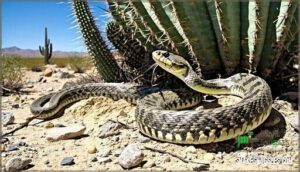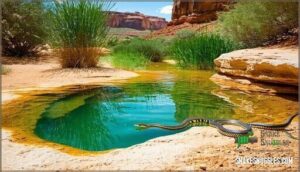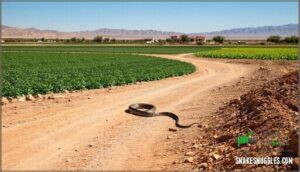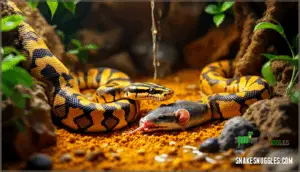This site is supported by our readers. We may earn a commission, at no cost to you, if you purchase through links.
 Desert snakes don’t just survive in one of Earth’s harshest environments—they’ve mastered it. These reptiles thrive where temperatures swing from scorching days to freezing nights, where water is scarce, and where exposed ground offers little protection.
Desert snakes don’t just survive in one of Earth’s harshest environments—they’ve mastered it. These reptiles thrive where temperatures swing from scorching days to freezing nights, where water is scarce, and where exposed ground offers little protection.
Their success comes from adaptations refined over millions of years: burrowing deep into sand to escape heat, conserving water through specialized kidneys, and hunting with venom or constriction depending on their species.
From the Sonoran Desert’s sidewinders to the Sahara’s sand vipers, over 200 venomous and non-venomous species call deserts home. Understanding their habitats reveals how these special creatures turn barren landscapes into hunting grounds and why knowing which snakes share your desert matters for both safety and appreciation.
Table Of Contents
- Key Takeaways
- Desert Snake Adaptations
- Desert Habitat Types
- Venomous Desert Snakes
- Non-Venomous Desert Snakes
- Desert Snake Distribution
- Frequently Asked Questions (FAQs)
- How do snakes adapt to the desert biome?
- Where do snakes like to hide in the desert?
- What is the best habitat for a snake?
- Can you find a snake in the desert?
- How do snakes navigate desert storms safely?
- What role do snakes play in desert ecosystems?
- Can snakes hear in the desert environment?
- Do desert snakes have unique mating rituals?
- How do snakes protect themselves from sandstorms?
- How do desert snakes reproduce and care for young?
- Conclusion
Key Takeaways
- Desert snakes survive extreme conditions through specialized adaptations including burrowing to escape heat, water-conserving kidneys that produce concentrated urine, and camouflage patterns that help them hunt and avoid predators.
- Over 200 snake species inhabit desert regions worldwide, divided between venomous types like rattlesnakes and cobras that use heat-sensing pits for hunting, and non-venomous species like kingsnakes and coachwhips that rely on constriction or speed.
- These snakes occupy specific desert microhabitats including sandy dunes, rocky outcrops, and areas near cacti or water sources, with some species adapting to agricultural lands as human settlements expand into desert areas.
- Climate change is reshaping desert ecosystems, making it increasingly important to identify which species share your space for both safety and conservation, as snakes play critical roles in controlling rodent populations and maintaining ecological balance.
Desert Snake Adaptations
Desert snakes have evolved impressive ways to survive in some of Earth’s harshest environments. From managing extreme heat to finding water where there seems to be none, these reptiles showcase nature’s problem-solving at its finest.
Let’s look at the key adaptations that help them thrive in desert conditions.
Burrowing and Shelter
When the desert sun turns rocks into griddles and sand into furnaces, snakes need a place to escape the heat. That’s where burrowing comes in. Desert snakes dig into sand or squeeze beneath rocks to create shelter that fulfills multiple purposes:
- Escape extreme surface temperatures
- Hide from predators like hawks and coyotes
- Conserve energy during inactive periods
- Retain precious body moisture
This habitat modification isn’t just about comfort. Burrowing benefits include thermoregulation and survival in one of Earth’s harshest environments.
Thermoregulation Strategies
After finding refuge underground, you still face the daily challenge of managing your body temperature in the desert. Thermoregulation strategies like basking behavior and microhabitat selection keep you alive. You’ll flatten your body against warm rocks during cool mornings to absorb heat faster. When temperatures climb above 30°C, you’ll shift between sun and shade multiple times per hour.
Activity timing matters too. During peak heat, you’ll stay nocturnal and reduce surface time by up to 70%. Western Rattlesnakes maintain body temperatures near 29°C, retreating before hitting dangerous levels around 31°C.
Hydration effects influence temperature choices. When water is scarce, you’ll select cooler spots to conserve moisture. These snake adaptations showcase striking reptile physiology fine-tuned for desert habitat survival. Similarly, snakes use thermal patches to regulate body temperature.
Camouflage Techniques
Once you’ve figured out temperature control, your next trick is staying invisible—and desert snakes have mastered this art through colors, patterns, and strategic placement. Camouflage evolution has given these reptiles survival tools that improve both predator evasion and hunting efficiency. You’ll notice these snake adaptations in action:
- Color matching blends scales with sand, rocks, or vegetation
- Disruptive patterns break up body outlines against varied backgrounds
- Background selection places snakes where they’re hardest to spot
- Mimicry copies dangerous species to deter threats
These predator-prey dynamics keep desert snakes alive in harsh desert habitat conditions.
Water Conservation Methods
Staying hidden works well, but survival also demands smart water use. Desert snakes rely on metabolic adaptations that extract moisture from prey and produce concentrated urine through specialized kidney function. Thick scales seal in hydration and prevent evaporation. Nocturnal behavior reduces exposure to drying heat.
Some species practice dew collection by positioning themselves where moisture condenses at dawn. These water conservation strategies let desert snakes thrive where rainfall barely exists, turning harsh desert habitat into livable space through physiological precision.
Desert snakes collect dew at dawn and conserve water through specialized physiology, thriving where rainfall is nearly nonexistent
Some rattlesnakes even coil into rain-collecting bowls to harvest water.
Desert Habitat Types
Desert snakes don’t just live anywhere in the desert. They seek out specific habitat types that meet their survival needs.
Let’s explore the main environments where you’ll find these resilient reptiles.
Sandy Dunes and Rocky Outcrops
Sandy dunes and rocky outcrops are the backbone of desert snake survival, offering natural hideouts and hunting grounds that make life possible in one of Earth’s harshest environments. Dune snake burrows provide refuge from extreme heat, while outcrop microclimates create cooler zones for thermoregulation.
These desert habitats support essential adaptations like camouflage against sand and rock. Habitat connectivity between dunes and outcrops allows desert snakes to hunt efficiently. Shelter availability depends on erosion impact and rock formation stability.
Cactus and Succulent Plants
In the unforgiving stretch of desert terrain, cactus and succulent plants become lifesaving landmarks for snakes seeking relief from relentless sun and dehydration. These plants create essential microhabitats within desert ecosystems, offering plant shade that drops ground temperatures by several degrees.
You’ll find snakes coiled beneath prickly pear and barrel cacti, using them as a water source and snake protection from predators.
This plant relationship demonstrates striking adaptation, as habitat diversity increases where succulents thrive, supporting broader desert wildlife populations and strengthening the resilience of desert habitats.
Springs and Oases
Where water breaks through parched earth, desert springs transform into bustling biodiversity hotspots that snakes can’t resist. These spring ecosystems provide critical water availability that bolsters prey populations and vegetation. You’ll witness striking snake dependence at oases biodiversity zones where multiple species converge.
These adaptations demonstrate why springs remain irreplaceable for desert snakes.
- Water conservation guarantees desert wildlife survival
- Desert ecosystems thrive around permanent water sources
- Habitat conservation protects these fragile desert habitats
Agricultural Lands and Human Settlements
As farms and towns push deeper into the desert, you’re likely to cross paths with snakes that have learned to live alongside us. Habitat encroachment drives human-snake conflict as these reptiles adapt to urban environments.
They’re drawn to agricultural areas where rodents are plentiful and irrigation systems provide water. Snake bites increase near human settlements, making wildlife conservation and habitat preservation essential.
Understanding snake behavior helps reduce conflict while protecting these desert snakes in rapidly changing landscapes.
Venomous Desert Snakes
Desert environments host some of nature’s most dangerous serpents. These venomous snakes have evolved specialized adaptations that allow them to thrive in harsh conditions while posing significant risks to humans and animals.
Let’s examine the key venomous species you might encounter in desert regions.
Rattlesnakes and Their Habitats
Rattlesnakes have turned the harsh desert into their personal hunting ground, and you’ll find them everywhere from sun-baked rocks to hidden burrows beneath the sand. These venomous snakes use heat-sensing pits to track prey in complete darkness. Rattlesnake behavior changes with temperature—they hunt at night during summer and bask during cooler months. Habitat loss threatens many species, making conservation status a growing concern.
- Western Diamondback: Potent rattlesnake venom causes tissue damage
- Mojave Rattlesnake: Neurotoxic venom affects the nervous system
- Sidewinder: S-shaped movement across hot sand minimizes contact
- Speckled Rattlesnake: Rocky terrain specialist with excellent camouflage
Cobra and Viper Species
Beyond the familiar rattle of their North American cousins, desert cobras and vipers have mastered survival in some of the world’s most unforgiving landscapes.
Desert Cobras prowl North African and Middle Eastern deserts with neurotoxic venom that attacks your nervous system. Desert Horn Vipers use ambush hunting strategies, burying themselves in sand with only their horned scales visible.
You can identify species by head shape and geographic distribution range, though many face declining conservation status from habitat loss.
Desert Death Adder and Other Venomous Species
While cobras and vipers dominate headlines, the Desert Death Adder and several lesser-known species deliver some of the most potent venom in the reptile world. You’ll find these venomous snakes in desert habitat regions where their venom potency and specialized fang morphology make them deadly hunters:
- Envenomation effects cause rapid paralysis in prey
- Antivenom efficacy varies considerably between species
- Venom evolution reflects millions of years adapting to desert conditions
Understanding these venomous species helps you recognize true snake bite risks.
Snakebite Prevention and Treatment
You can avoid snake bites with protective footwear and by staying alert during evening hours when snakes are most active. If bitten, seek medical care immediately.
Antivenom access remains limited in many desert regions, with some areas having less than 3% of needed supplies. First aid involves keeping calm and immobilizing the affected limb.
Community education programs have cut snakebite deaths by 30% in some regions. Traditional healers now receive training to recognize venomous snake symptoms and refer victims quickly to hospitals where proper toxicology care is available.
Non-Venomous Desert Snakes
Not all desert snakes carry venom. Many species rely on constriction or speed to catch their prey instead.
Here’s a look at four common non-venomous snakes you might encounter in desert environments.
Desert Kingsnakes and Their Prey
Desert Kingsnakes earn their name by doing something most snakes would never dare—they hunt and eat other snakes. Their venom resistance lets them tackle rattlesnakes and other venomous species without harm. These nonvenomous snakes use constriction as their hunting technique.
You’ll find them feasting on lizards and desert rodents too. Their prey specificity shapes predator-prey dynamics across desert ecosystems. This dietary impact creates unique coexistence strategies where kingsnakes control populations of other Desert Snake Species.
Gopher Snakes and Their Habitats
Gopher Snakes mightn’t eat other snakes, but they’re just as skilled at surviving in harsh desert terrain. You’ll find these nonvenomous snakes thriving across sandy dunes and rocky outcrops where their diet centers on rodents and small mammals. Their habitat preferences include areas with loose soil for burrowing.
When threatened, they mimic rattlesnakes by hissing and vibrating their tails—a clever predator avoidance strategy that keeps larger animals at bay.
Glossy Snakes and Their Diet
If you’re wondering what keeps Glossy Snakes thriving in the Mojave Desert, their menu holds the answer. These nonvenomous snakes feast primarily on small lizards, relying on prey abundance in rocky outcrops and sandy terrain. Their hunting strategies include ambush tactics at night when desert wildlife is most active. Dietary adaptations like low metabolic rates allow infrequent feeding—sometimes weeks between meals. You’ll appreciate how these snake species survive extreme conditions through smart lizard consumption and efficient energy use.
What makes their survival noteworthy:
- They can go weeks without eating thanks to incredibly slow digestion
- Their nighttime hunts coincide perfectly with when lizards are most vulnerable
- Young lizards make up most of their diet, requiring less energy to capture
- They’ve mastered the art of patient waiting rather than wasting energy chasing prey
Coachwhips and Other Non-Venomous Species
When Coachwhips streak across the desert floor at speeds reaching 4 miles per hour, they’re not just fast—they’re rewriting the rules of how nonvenomous snakes survive in harsh terrain. These desert snakes use hunting strategies that rely on active pursuit rather than ambush. Gopher snakes and other nonvenomous species adapt differently based on regional variations in their desert habitat.
Key identification tips for common species:
- Coachwhips grow up to 8 feet and display thin bodies built for speed
- Gopher snakes mimic rattlesnakes by vibrating their tails when threatened
- Desert Kingsnakes sport bold yellow and black patterns
- Rosy Boas move slowly and hunt at night in rocky areas
- Most have stable conservation status due to adaptable ecological impact
Desert Snake Distribution
Desert snakes don’t stick to one type of landscape. They’ve spread across every major desert on the planet, from the scorching Sonoran to the vast Sahara.
Let’s look at where these species make their homes around the world.
Global Desert Regions and Snake Species
Over 209 species of venomous Desert Snakes thrive across global Desert Ecosystems, with the highest Regional Snake Movement projected by 2070. You’ll encounter diverse Snake Species in Australia’s Great Victoria Desert, the Sahara Desert, and South America’s Chaco region.
Climatic Snake Constraints shape these habitats—Western Australia’s deserts hit 123°F, while the Sonoran Desert features iconic rattlesnakes. Desert Snake Diversity peaks where soil composition and temperature create ideal conditions.
Human Impacts like agricultural expansion introduce new Key Species into Nepal, Niger, and Myanmar, increasing encounters in previously snake-free zones.
North American Deserts and Their Inhabitants
You can’t throw a rock in the Mojave, Sonoran, Chihuahuan, or Great Basin deserts without coming close to at least one of the 48 snake species calling these harsh landscapes home. Rattlesnakes dominate these regions, with Sidewinders gliding across sandy dunes. Desert Kingsnakes hunt lizards near rocky outcrops while Gopher Snakes patrol agricultural edges.
Desert conservation efforts protect these Mojave snakes and Sonoran species from habitat loss.
Australian and Asian Desert Snakes
The Australian outback and Asian deserts breed some of the planet’s most lethal serpents, where survival means mastering extreme heat and scarce resources. You’ll find the Inland Taipan—the world’s most venomous snake—alongside Australian Pythons in the arid outback. Asian Vipers and Desert Cobras patrol Middle Eastern sands, while the Moloch Habitat sustains unique reptiles.
These snake species use specialized adaptation strategies like nocturnal hunting and water-efficient metabolism. Conservation status varies, but habitat loss threatens many desert snakes across these regions.
African Desert Snakes and Their Habitats
Africa’s harsh deserts forge some of the most heat-adapted and venomous snakes on Earth, from Saharan sands to Kalahari scrublands. You’ll encounter Sahara Vipers and the desert cobra across North Africa, while African cobras patrol diverse habitats. Mamba venom ranks among the deadliest.
Habitat loss threatens these desert snakes, making conservation efforts critical for protecting venomous snakes in African desert habitat ecosystems.
Frequently Asked Questions (FAQs)
How do snakes adapt to the desert biome?
Like a mirage shimmering on scorching sand, desert snakes rely on burrowing behavior, thermoregulation, and camouflage to thrive where water is scarce.
These snake adaptations and behavior include seeking shade, conserving moisture through water retention, and dietary adaptations that help them survive extreme conditions.
Where do snakes like to hide in the desert?
Desert snakes seek shelter in burrow microclimates beneath rocks and logs, where temperatures stay cooler.
They use camouflage to blend into sand and crevices for predator avoidance.
These ambush spots also serve as molting locations and hibernation sites throughout the year.
What is the best habitat for a snake?
What makes an ideal snake habitat work? Snakes thrive where shelter options, prey availability, and water sources align with habitat temperature needs. Rocky outcrops, forests, and desert ecosystems and snakes coexist when hiding spots and food appear nearby.
Snake behavior and habitat preferences vary, but desert wildlife and snakes flourish in areas offering thermal refuges and consistent resources.
Can you find a snake in the desert?
Yes, you can find snakes in the desert. Desert Snakes thrive in hot, arid environments. They hide under rocks, burrow in sandy areas, and seek shade during the day.
Camouflage helps them blend into Desert Ecosystems, making Snake identification challenging.
How do snakes navigate desert storms safely?
Strong winds and blinding sandstorms won’t stop desert snakes from finding safety. You seek storm shelter in underground burrows or rocky crevices using sensory adaptations that detect pressure changes.
Burrow stability protects you from collapsing sand while flood avoidance instincts guide you to higher ground.
Post-storm behavior includes emerging cautiously to resume hunting.
What role do snakes play in desert ecosystems?
Snakes are essential to desert ecosystems. They control rodent populations that would otherwise overeat vegetation.
They serve as prey for hawks and other predators. This predator-prey relationship maintains ecological balance.
Without snakes, species diversity would decline and ecosystem balance would collapse.
Can snakes hear in the desert environment?
No, snakes don’t hear through traditional sound waves. Their inner ear anatomy detects ground vibrations through their lower jaw and body scales—an important survival strategy in desert environments.
This reptile physiology allows predator detection by sensing tremors in sand and rock, making desert acoustics work differently for them than for mammals.
Do desert snakes have unique mating rituals?
Many desert snake species showcase elaborate courtship behaviors during reproductive timing. Males use pheromone usage to track females and perform intricate dances or combat rituals with rivals. These displays help establish dominance and attract mates in harsh environments.
How do snakes protect themselves from sandstorms?
When sandstorms roll in, you’ll find desert snakes diving deep underground through burrowing or tucking into rocky crevices.
Their Scale Protection and specialized sensory adaptations help them detect approaching winds early, triggering these survival strategies that shield them from sand blasts.
How do desert snakes reproduce and care for young?
Most desert snakes lay eggs or give live birth during cooler months. Clutch size varies by snake species.
Parental care is minimal—hatchling survival depends on camouflage and instinct to find shelter, water, and prey independently in harsh desert conditions.
Conclusion
As climate change reshapes desert ecosystems, understanding the desert habitat for snakes becomes more critical than ever. These reptiles show us how life adjusts to extremes through specialized kidneys, heat-sensing pits, and nocturnal hunting patterns.
Whether you’re hiking through rocky outcrops or living near sandy expanses, recognizing which species share your space—from venomous rattlesnakes to harmless kingsnakes—keeps you safe while deepening your respect for creatures that turned scarcity into survival mastery.
Desert snakes aren’t just surviving. They’re thriving where most life can’t.
- https://en.wikipedia.org/wiki/List_of_deserts_by_area
- https://californiaherps.com/snakes/pages/s.h.hexalepis.html
- https://www.livescience.com/43559-black-mamba.html
- https://www.academicpublishers.org/journals/index.php/ijzs/article/download/5670/6596/12993
- https://www.fsl.orst.edu/rna/Documents/publications/Daily%20variation%20in%20the%20body%20temperatures%20of%20free-ranging%20garter%20snakes%201987.pdf













